This article needs additional citations for verification .(January 2021) |

Jens Christian Jensen Klok (25 January 1889 - June 16, 1974) was a Danish architect. [1]
This article needs additional citations for verification .(January 2021) |

Jens Christian Jensen Klok (25 January 1889 - June 16, 1974) was a Danish architect. [1]
Jens Klok was born at Vinderslev Parish in Viborg, Denmark. He was the son of Laurits Klok and Karoline Adolfsen. He was first a mason apprentice and a construction manager before going to technical school and the Royal Danish Academy of Fine Arts, School of Architecture, where he graduated in 1929. He received the Academy Bursary award in 1925 and K. A. Larssens Legat 1927 and travelled to Italy, France and England to study key architectural influences. As an employee at the Royal Danish Naval Building Service and from 1935 Head of the Naval Architecture section, he designed a number of Navy buildings in a unique style. [2]
Jens Klok designed the Marine Air Station in Avnsø in 1937 and in Holmen, Copenhagen in 1939. He later designed the Royal Danish Naval Academy office building in 1940, with Holger Sorensen, and had a special exhibition of his works at Charlottenborg Spring Exhibition between 1942 and 1943. He also designed the Motor Torpedo Workshop in 1953.
In 1932, he married Marie Augusta Elisabeth Bech (1887-1977). He died in Varde during 1974.

The Royal Danish Academy of Fine Arts has provided education in the arts for more than 250 years, playing its part in the development of the art of Denmark.

Caspar Frederik (Friedrich) Harsdorff, also known as C.F. Harsdorff, was a Danish neoclassical architect considered to have been the leading Danish architect in the late 18th century.

Michael Gottlieb Birckner Bindesbøll was a Danish architect active during the Danish Golden Age in the first half of the 19th century. Most known for his design of Thorvaldsens Museum in Copenhagen, he was a key figure in the stylistic shift in Danish architecture from late classicism to Historicism. He was the father of the designer Thorvald Bindesbøll and the textile artist Johanne Bindesbøll.
Ejnar Mindedal, born Mindedal Rasmussen was a Danish Neoclassical architect. He was a traditionalist who adhered to the Danish da:Bedre Byggeskik movement which emphasized traditional Danish construction practices. However he did not shy from using modern materials like concrete in, for example, his breakthrough work 'Swimming Pool in Ollerup, for which he won a Silver Medal in the Architectural Design discipline at the 1928 Summer Olympics in Amsterdam.

Danish art is the visual arts produced in Denmark or by Danish artists. It goes back thousands of years with significant artifacts from the 2nd millennium BC, such as the Trundholm sun chariot. For many early periods, it is usually considered as part of the wider Nordic art of Scandinavia. Art from what is today Denmark forms part of the art of the Nordic Bronze Age, and then Norse and Viking art. Danish medieval painting is almost entirely known from church frescos such as those from the 16th-century artist known as the Elmelunde Master.
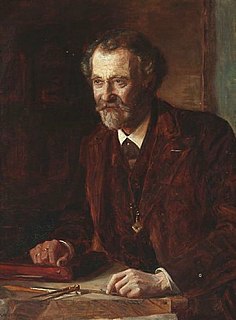
Jens Vilhelm Dahlerup was a Danish architect who specialized in the Historicist style. One of the most productive and noted Danish architects of the 19th century, he is behind many of the most known buildings and landmarks of his time and has more than any other single architect contributed to the way Copenhagen appears today.
Mogens Koch was a Danish architect and furniture designer and, from 1950 to 1968, a professor at the Royal Danish Academy of Fine Arts.
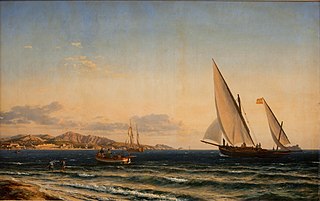
Carl Frederik Emanuel Larsen usually known as Emanuel Larsen was a Danish painter who specialized in marine painting.
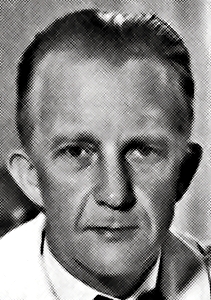
Niels August Theodor Kaj Gottlob, usually known as Kaj Gottlob, was a Danish architect who contributed much to Neoclassicism and Functionalism both as professor of the School of Architects at the Royal Danish Academy of Fine Arts and as a royal building inspector.
Fredrik Appel was a Danish architect.

Hans Christian Amberg was a Danish architect.

Alf Cock-Clausen was a Danish architect. He was active during the transition from Neoclassicism to Functionalism and many of his works show influence from Art Deco. His factory for the distillery De Danske Spritfabrikker at Aalborg's harbour front was declared a Danish Industrial Heritage Site in 2009.

Jens Ingwersen was a Danish architect during the transition from neo-classicism to functionalism. He was the architect of the telephone company KTAS and is the man behind most of this company's buildings.
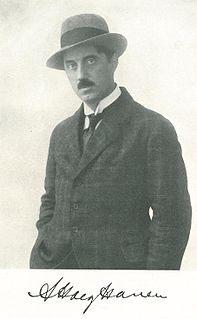
Axel Høeg-Hansen was a Danish architect. Stylistically he mainly worked in neoclassical and functionalist styles. He primarily worked in and around Aarhus at the turn of the 20th century.

Tyge Hvass was a Danish functionalist architect. He was most notable for his design work on the J.F. Willumsens Museum in Frederikssund.
Harald Magnus Lønborg-Jensen was a Danish architect known as a productive church and restoration-architect.

Heinrich August Georg Schiøtt was a Danish portrait painter.
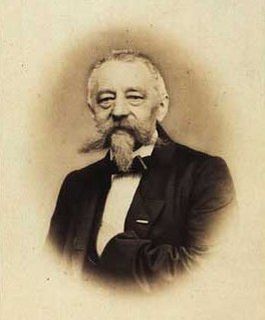
Niels Simonsen was a Danish painter, lithographer and sculptor.
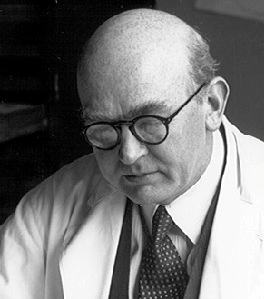
Harald Nielsen was a Danish designer of silver for Georg Jensen. The younger brother of Georg Jensen's third wife, he joined the company at 17 as a chaser's apprentice but later became one of the company's leading designers in the 1920s and 1930s and Jensen's closest colleague, One of his most well-known designs being the pyramid flatware pattern. In the early 1950s he headed the company's apprentice school and in 1958 became its artistic director.

Jens Lund Jensen was a Danish sculptor.
This biography is a translation of the Danish Wikipedia version that has additional references.